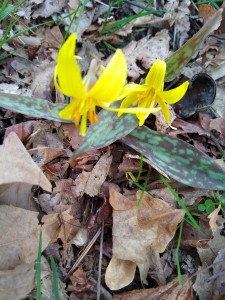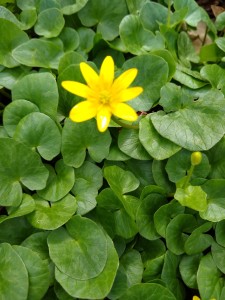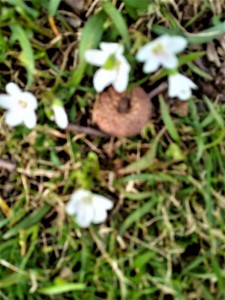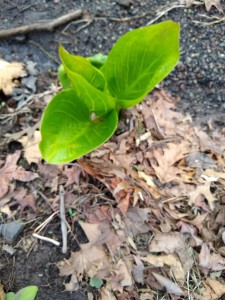Everyone loves wildflowers. Several weeks ago, when a wildflower “super bloom” occurred in a small section of southern California desert, tourist volume swelled to gargantuan size and the internet went crazy. It is a reassuring sign that we have not completely lost touch with the natural world.

Despite all that love, wildflowers are disappearing in a hurry. The finger of blame points in many directions—development that encroaches on “wild” areas, pollution, and loss of pollinating species, to name a few. Some species have died out completely, while others are endangered.
That is why wildflowers seem both serendipitous and miraculous wherever they pop up. It is spring, when the greatest numbers of wildflowers, especially woodland species, unfurl their leaves and flower. If you know where to look you can still find lots of them. I set about searching for these seasonal gems on my regular daily walks.
The first ones I discovered were marsh marigolds, known botanically as Caltha palustris. From a distance you might think these golden low-growers are either small dandelions or large buttercups. The buttercup resemblance comes naturally. Both species are members of the Ranunculaceae or buttercup plant family. The common name is a bit misleading. “Marsh” is highly descriptive, because the little flowers prefer wet or even marshy soil and frequently make appearances near stream beds and low lying areas. “Marigold” is more problematic. Marsh marigolds are no relation to the common garden annuals that adorn our beds and borders in summer. The nickname is probably based on the color similarity between the two plant types.
I saw numerous clumps of marsh marigolds on walks in local parks and even on the edges of some lawns. The glossy, rounded green leaves remind me a little bit of violet leaves. The plants are easy to spot when the golden flowers bloom, but lapse into anonymity afterwards.

Violets were everywhere, still winsome and beautiful despite their ubiquity. But one kind of “violet” stood out —dogtooth violet or Erythronium americanum. This gorgeous plant is also known as “trout lily” or “adder’s tongue”, and features small, lily-like flowers with reflexed or back-turned petals. The blooms are yellow and the long, ground-hugging leaves are green splotched with brown. The leaf markings bear a resemblance to those of fish in the trout family.
The nickname “dogtooth violet” comes from a European relative, Erythronium dens-canis, which has the same flower configuration, but blooms in pink, white or purple-pink. Early settlers most likely encountered native trout lilies, noticed the resemblance to the European wildflowers and bestowed the nickname.
In the parks where I have spotted dogtooth violets, people walk over the mottled leaves every day, but only notice the little plants when the flowers bloom. These lily-family members also favor woodland edges and low-lying spots.
The same parks where I saw violets, trout lily and marsh marigolds are also home to Claytonia virginica, known commonly as “spring beauty”. Growing atop slender stalks that are six inches tall at best, the five-petaled flowers are white with pink veins and pink anthers. Hard-to-see grass-like leaves complete the Claytonia picture. On rainy or overcast days they close up their petals like little umbrellas, but open wide again when the sun returns.
Claytonia also crops up in some lawns in my neighborhood. The plants, which grow from underground corms, will spread nicely if they are happy and will disappear obligingly before you cut your grass for the first time.

Skunk cabbage or Symplocarpus foetidus is not a cabbage, but it does have a stinky odor and is on display now in marshes near you. The plants begin sprouting in early spring, even while the weather is quite cold, because they have the ability to generate enough heat to allow the shoots to push up through cold ground…The flowers appear first, and with their hooded “pulpit” appearance bear a resemblance to their Araceae family relatives calla lilies and jack-in-the pulpits. After the flowers fade, the leaves emerge in big, cabbage-like masses slightly reminiscent of unfurling hosta leaves. If crushed or bruised, they smell “skunky”, as do the flowers. This foul smell not only repels potential plant destroyers, but attracts the flies and gnats that pollinate the flowers.
Because of this little bit of olfactory unpleasantness, skunk cabbage is somewhat less enchanting to the general public than other wildflowers. They are no less miraculous.
The best places to find spring wildflowers are in marginal areas—woodland edges, unmanicured places in public parks, near streams and ponds, and in lawns whose owners don’t practice the scorched earth method of lawn and garden maintenance. The wildflowers come into their glory in spring and then hide away for the rest of the year. During that brief time, they are as magical as they are ephemeral. It is worth seeking them out.

